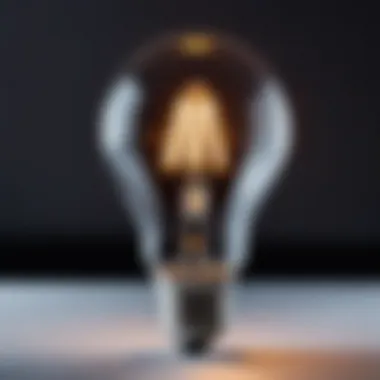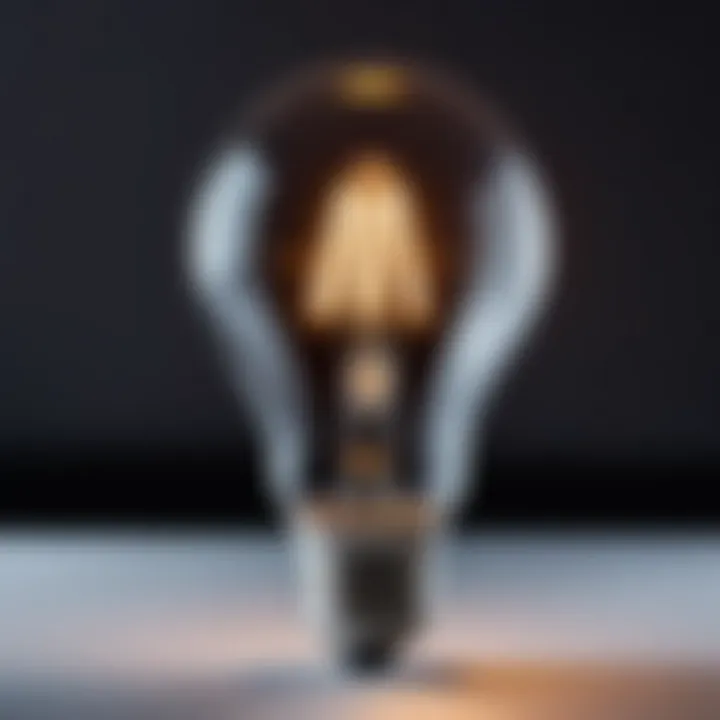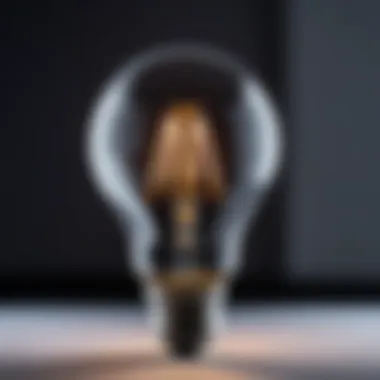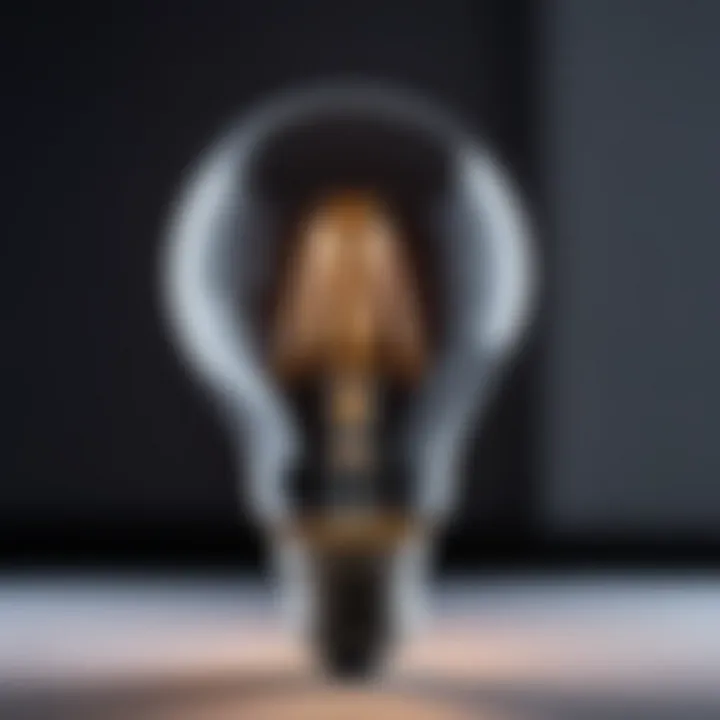Exploring the Н15 Light Bulb: Key Features and Benefits


Intro
The Н15 light bulb marks a significant advancement in lighting technology, acting as a bridge between traditional bulbs and the more energy-efficient solutions that are taking the market by storm. This article aims to shine a light on the specifications, common usage scenarios, and the economic advantages of the Н15 bulb. It's not just another light source; it's a step towards smarter energy use and sustainability, catering to individuals and families who prioritize efficiency and cost-effectiveness.
In an era where everyone is looking to stretch a dollar, the Н15 provides insights into why energy-efficient bulbs are not just a trend but a necessity. From its design to its implications on energy savings, comprehending the Н15’s features is vital for making informed decisions. By the end of this article, readers will have a thorough understanding of not just the bulb itself but also the broader context of lighting solutions available today.
Актуальные акции и скидки
Обзор текущих предложений
In the lively world of lighting, promotions and discounts for Х15 bulbs pop up quite frequently. Many reputable retailers and manufacturers offer competitive pricing, especially during seasonal sales or product launches. Keeping an eye out for such deals could make a difference in household budgets. For example, major chains might provide limited-time offers or bundle deals that make purchasing Н15 bulbs even more economical.
Специальные предложения от популярных брендов
Some of the most recognized brands in the lighting industry often run special promotions. Brands like Philips, Osram, and GE are known for both their innovation and occasional sales that highlight their latest products. Signing up for newsletters or following these brands on social media can alert consumers to price cuts and exclusive promotions.
Рекомендуемые товары
Топ товаров со скидками
For those diving into the Н15 bulb realm, it's wise to consider models that come highly recommended. Products with robust performance and customer reviews can guide buyers. Here’s a list of some popular Н15 bulbs that typically see discounts:
- Philips Н15 LED: Known for its brightness and color accuracy.
- Osram Energy Saver Н15: A great choice for budget-conscious individuals.
- GE Bright Stik Н15: Favored for its versatility and compatibility with various fixtures.
Товары, которые стоит купить по сниженной цене
When hunting for value during sales, focus on durability and energy efficiency. Some products may tempt with low prices but offer limited longevity. Consider investing in:
- Sylvania Н15 Bulbs: They boast a longer lifespan and consistent output.
- Cree Н15 LED: Renowned for high efficiency and low energy consumption.
These recommendations point to a notion that understanding the landscape of Н15 bulbs isn't just about selection but also about timing and awareness of market trends. Balancing quality and cost is key in making smart purchases that ensure brighter results.
Prelims to Н Light Bulbs
The Н15 light bulb has emerged as a vital component in the realm of modern lighting solutions. Its significance lies not only in its technical capabilities but also in how it meets the demands of today’s energy-conscious consumers. This section seeks to elucidate the noteworthy characteristics of Н15 bulbs, diving into both their definition and historical evolution. By understanding these essentials, readers can appreciate why this bulb is a prevalent choice in various applications.
Definition and Characteristics
The Н15 bulb stands out because it combines efficiency with versatility. Typically, these bulbs emit a bright, focused beam of light, often used in diverse settings ranging from homes to automotive applications.
Key characteristics include:
- Wattage: Н15 bulbs often function within a range of 30 to 100 watts, providing options for different brightness needs.
- Design: Most are designed to offer a standard base fit, making them compatible with existing fixtures without the need for alterations.
- Light Output: The lumens produced by Н15 bulbs provide a substantial increase in visibility, thereby enhancing spaces effectively.
- Color Temperature: Available in various temperatures, including warm and cool white, they suit different environments, whether for relaxation or productivity.
Understanding these elements aligns with the modern shift toward energy-efficient solutions while catering to consumer preferences for adaptability and performance.
Historical Development
Tracing back the journey of Н15 bulbs reveals a fascinating evolution marked by innovation and a response to consumer needs. Originally, lighting technology was limited to incandescent lamps, which, while common, were energy-intensive and short-lived. As the world turned its focus to sustainability and cost-effectiveness, the Н15 bulb was developed to address these issues directly.
Here are some pivotal points in its history:
- Introduction of Halogen: The Н15 variant became more prominent with the rise of halogen technology. In the late 20th century, these bulbs revolutionized lighting with their enhanced output and longer life spans compared to traditional options.
- Shift to Energy-Efficiency: With the advent of environmental awareness in the early 2000s, the Н15 bulb adapted once more, integrating advancements that improved energy consumption, fulfilling both regulatory standards and consumer demand for greener choices.
- Current Trends: Today, Н15 bulbs exemplify a blend of tradition and technology. Manufacturers continuously innovate, incorporating smart features that allow for greater control, efficiency, and user comfort.


Understanding the historical context of Н15 light bulbs provides insight into how they have shaped current lighting solutions. This backbone allows consumers to make informed decisions about their lighting needs, especially when considering the economic and environmental implications of their choices.
Technical Specifications of Н Bulbs
Understanding the technical specifications of Н15 bulbs is crucial for anyone looking to optimize their lighting setup. The intricate details behind these specifications not only dictate the bulb’s performance but also influence its overall energy efficiency and longevity. As energy-efficient lighting becomes increasingly vital, diving into the specific elements like voltage, wattage, lumens, and durability isn't just academic; it’s practical. By grasping these aspects, homeowners and professionals alike can make informed decisions that lead to better light quality and lower electricity bills.
Voltage and Wattage Considerations
When it comes to Н15 bulbs, voltage and wattage are two peas in a pod, working hand in hand to determine the bulb's efficiency and output. Typically, these bulbs operate at a standard voltage of 12 volts, which is fairly manageable and compatible with many lighting systems.
- Wattage affects how much energy the bulb consumes. For instance, a bulb rated at 55 watts usually outputs sufficient light for automotive settings, while options exist as low as 35 watts for more subtle needs.
- Choosing the right wattage can mean the difference between light that's bright enough to illuminate a garage workshop and one that merely offers a faint glow.
A practical approach is keenly understanding your lighting needs before installation, as using higher wattage than necessary not only wastes energy but also reduces the bulb’s lifespan.
Lumens and Efficiency Ratings
Lumens measure the amount of visible light emitted by a bulb, helping you gauge how bright the light will be in practice. An Н15 bulb's lumen output typically ranges from 900 to 1,500, making them suitable for various applications, from home to automotive.
Efficiency ratings, often expressed as lumens per watt, reflect a bulb's performance. A higher lumen output per watt indicates a more energy-efficient product. For instance:
- A 55-watt Н15 bulb producing 1,200 lumens achieves about 21.82 lumens per watt, indicating solid efficiency.
- Alternatively, a bulb producing only 800 lumens at the same wattage gives a less favorable rating.
Selecting bulbs with higher efficiency ratings can drastically enhance energy savings over time, appealing to environmentally-conscious consumers and those intent on reducing energy costs.
Lifespan and Durability
Lifespan is a significant factor when considering Н15 bulbs, as it dictates how often you'll need to replace them. Most Н15 bulbs have a lifespan ranging between 500 to 1,000 hours, depending on the quality of the bulb and how it's used. This reliability often makes them a popular choice for both residential and commercial use.
Durability should not be overlooked either; these bulbs are designed to endure vibrations and shocks, especially in automotive contexts. Selecting a bulb that stands the test of wear and tear can save money in replacement costs and reduce waste, aligning perfectly with contemporary sustainability goals.
"Choosing the right lighting technology is not only about illumination; it's also about long-term benefits for both your wallet and the environment."
In summary, understanding the technical specifications of Н15 light bulbs allows users to make educated decisions that enhance both energy efficiency and lifecycle. By paying attention to the interplay between voltage, wattage, lumens, and durability, consumers can maximize their lighting investments while minimizing their environmental footprints.
Common Applications of Н Bulbs
Understanding the various applications of Н15 bulbs is essential. The versatility of these light sources allows them to fit in different environments, thus providing innovative solutions across residential, commercial, and automotive needs. By recognizing the unique benefits and considerations tied to each application, readers can make informed decisions based on their own requirements. Let's break down how Н15 bulbs shine in these settings.
Residential Lighting Solutions
In homes, Н15 bulbs are a beacon of versatility. They can be used in basements, living rooms, and kitchens. A popular choice for reliability and warmth, these bulbs often create an inviting atmosphere. For example, using Н15 in recessed lighting can enhance the overall ambiance of a space. It's like giving your home a warm hug.
Benefits of Н15 in residential setups:
- Energy Efficiency: They consume less power compared to traditional incandescent bulbs, leading to savings on energy bills.
- Lifespan: Typically, they last much longer than older bulbs, reducing the frequency of replacements.
- Variety in Design: Available in different silhouettes, Н15 bulbs can cater to various aesthetic preferences.
A well-lit home can make a profound difference in mood and productivity. The Н15 light bulb can subtly transform not just beliefs about lighting but also behaviors related to comfort in personal spaces.
Commercial Utilization
In the commercial sphere, Н15 bulbs find their way into offices, restaurants, and retail spaces. Business owners increasingly recognize that the right lighting can impact customer experience and employee motivation. Think about a coffee shop utilizing soft, warm Н15 light for a cozy atmosphere. Customers are more likely to stay longer — and yes, enjoy another cup of coffee while they’re at it!
Advantages in commercial settings:


- Cost-Effectiveness: On top of lower energy consumption, the durability of Н15 bulbs reduces replacement costs.
- Enhanced Branding: Effective lighting can enhance product displays, draw attention, and even elevate a brand's image.
- Versatile Applications: They can be adapted to various fixtures, from pendants to chandeliers.
Lighting’s role in commercial areas goes beyond mere visibility. It's about creating an environment that supports business goals and attracts clientele. Utilizing Н15 bulbs can be a significant step in achieving that ideal atmosphere.
Specific Use Cases in Automotive Lighting
When it comes to vehicles, Н15 bulbs do not just illuminate roads; they set standards for safety and efficiency. They're commonly employed in headlamps, and fog lights, offering good visibility for the driver while creating a robust visual appeal.
Key considerations for automotive applications:
- Safety: Bright, clear light output from Н15 bulbs can help ensure that road hazards are visible.
- Regulatory Compliance: Many jurisdictions require specific brightness and clarity levels for vehicle lighting. Н15 bulbs typically meet these standards effectively.
- Durability in Harsh Conditions: Their ability to withstand vibrations and varied temperatures makes them reliable for long-term use.
An effective lighting mechanism within vehicles is vital for not only a good driving experience but safety on the roads. It’s an interesting link between technology, human behavior, and safety regulations.
In summation, the Н15 light bulb is not confined to one application but reaches into various sectors. Recognizing the benefits across different contexts empowers individuals and businesses to make smart choices. Their emphasis on energy efficiency and longevity is not just about saving money; it’s also about contributing to a sustainable future.
Cost Analysis and Economic Implications
Understanding the economic implications of Н15 light bulbs is essential for consumers who are conscious about their expenses and environmental footprints. This analysis sheds light on how the initial costs stack against long-term savings, compares Н15 bulbs with traditional lighting solutions, and identifies current market trends alongside consumer preferences.
Initial Investment vs Long-term Savings
When it comes to initial investment, Н15 bulbs might seem pricier at the outset. A typical bulb can range from $5 to $15 depending on brand and performance specifics. However, the costs are justified when one considers long-term savings.
- Energy Efficiency: Н15 bulbs consume significantly lesser energy, often translating to around 80% less compared to incandescent bulbs. With daily usage, this can result in a noticeable reduction on your monthly electricity bill.
- Lifespan: These bulbs generally last much longer, often exceeding 20,000 hours, whereas traditional bulbs may burn out after just 1,000 hours. This translates into fewer replacements, further reducing costs over time.
In summary, while the initial price tag may be intimidating for some, the savings accumulated over years of use paint a different picture—one where the consumer benefits financially.
Comparison with Traditional Lighting Options
When juxtaposing Н15 bulbs with traditional options, such as incandescent or fluorescent lights, the differences become glaringly evident. Here are several factors worth considering:
- Cost of Electricity: Incandescent lights are notorious for their high energy consumption. With Н15 bulbs, users experience far lower bills. For instance, if a household replaces ten 60-watt incandescent bulbs with Н15 equivalents, the energy savings can be staggering.
- Maintenance: The longevity of Н15 bulbs means that the headache of frequently changing bulbs is significantly reduced. This not only saves money but also the time and effort it takes to swap out burnt bulbs.
- Heat Production: Traditional bulbs waste a lot of electricity as heat, which can lead to higher cooling costs in warmer months. Н15 bulbs, designed to emit less heat, avoid this issue.
Overall, switching to Н15 bulbs from traditional lighting is more than just a smart energy choice; it’s a financially savvy move.
Market Trends and Consumer Preferences
Examining the market for Н15 bulbs reveals some interesting trends. Today, there is a growing preference for energy-efficient lighting among consumers. This shift is partly driven by rising electricity costs and environmental awareness.
- Increased Demand: More households and businesses are investing in Н15 bulbs as part of their commitment to sustainability. This uptick in demand has led manufacturers to innovate and improve designs, often resulting in better performance and affordability.
- Awareness Campaigns: Many consumers are educated about energy consumption through various channels—social media, print, and television. As more people learn about the economic and environmental benefits of Н15 bulbs, their popularity continues to rise.
- Online Shopping Trends: Consumers today prefer shopping online, which has led to increased availability and competitive pricing for Н15 bulbs. Online platforms often provide consumer reviews, allowing buyers to make informed choices.
"Investing in Н15 light bulbs is not just a purchase; it’s a step toward a more sustainable future and significant savings over time."
In summary, the economic implications of switching to Н15 bulbs encompass not just the financial aspect but also align with broader trends in sustainability and consumer awareness. It's clear that the choice to go with Н15 carries with it both immediate benefits and long-term value.
Environmental Considerations
Understanding the environmental implications of Н15 light bulbs is vital for consumers and businesses today. The global push towards sustainability makes it imperative to assess how these bulbs fit into a greener future. Light bulbs are not just sources of illumination—they can significantly influence energy consumption patterns, sustainability efforts, and waste management strategies.
Energy Consumption and Sustainability
Н15 light bulbs are renowned for their efficiency when it comes to energy usage. Unlike traditional incandescent bulbs, which tend to guzzle electricity, Н15 bulbs use much less power to achieve the same level of brightness. This not only translates into lower electricity bills for consumers but also reduces the overall demand on power plants.


"Switching to Н15 bulbs could bring substantial changes to our environment. Less energy used means less carbon released by power generation."
When evaluating energy consumption, it's important to look at wattage figures. Н15 bulbs offer higher lumens per watt. For instance, while a typical incandescent bulb may produce 800 lumens with a 60-watt rating, a Н15 bulb may produce the same amount of light with just 10 to 15 watts. This reduction in wattage leads to a significant cut in energy costs over time. Furthermore, lower energy consumption can decrease electricity generation's associated emissions, thereby aligning with global sustainability goals.
Recycling and Disposal Options
As we embrace these efficient alternatives, the question of what to do with light bulbs at their end-of-life stage arises. Н15 bulbs, particularly LED variants, are typically much easier to recycle than traditional incandescent bulbs. Many components of Н15 bulbs—like glass and certain metals—can often be repurposed, thus minimizing waste.
For responsible disposal and recycling of Н15 light bulbs, consumers should consider the following options:
- Local Recycling Centers: Many cities have dedicated recycling programs for light bulbs. Finding a local center that accepts Н15 bulbs can greatly reduce landfill contributions.
- Retail Takeback Programs: Some retailers offer programs where consumers can drop off their used bulbs for proper disposal and recycling. These initiatives can help streamline the recycling process and ensure that hazardous materials do not end up in landfills.
- Follow Regulations: Be informed about state or country-specific regulations regarding light bulb disposal, as some may have guidelines for hazardous waste.
Future Directions in Lighting Technology
The lighting industry is undergoing a revolution, and the Н15 bulb stands at the forefront of this change. As technology advances, the quest for energy efficiency and sustainability drives innovations in lighting. Focusing on the future directions in lighting technology is crucial, as it not only influences consumer choices but also shapes the environmental landscape we live in.
In this section, we will explore the growing adoption of LED and smart lighting technologies, along with the emerging role of Н15 in these advancements. The journey towards brighter, more efficient, and intelligently controlled lighting is where our present and future collide.
Advancements in LED and Smart Lighting
The shift towards LED technology has been nothing short of transformative. Unlike traditional incandescent bulbs that waste a lot of energy as heat, LEDs are designed to utilize nearly all the energy they consume for light production. This results in longer lifespans and substantial energy savings for consumers. Moreover, with longer durations between replacements, homeowners and businesses experience less hassle and lower costs associated with maintenance.
Smart lighting is another exciting avenue gaining traction. These modern systems can be controlled remotely via smartphones and can adapt to user preferences. Sensors detect motion and adjust the light levels accordingly, delivering light only when and where it’s needed. This not only provides convenience but also offers further energy savings. Smart grids and integration with home automation systems mean that lighting can be adjusted based on natural light availability, peak usage times, or personal habits, leading to a more sustainable use of resources.
"The future of lighting is about efficiency and flexibility, it's about creating environments that fit our lifestyle while conserving resources."
The combination of LEDs and smart technology signifies a notable shift. This isn't just about more light; it's about smarter choices that benefit our wallets and the planet alike.
The Role of Н in Emerging Technologies
The Н15 light bulb is poised to play a pivotal role in this evolving landscape. As manufacturers continue to innovate, the potential applications for Н15 bulbs become increasingly diverse. With their specific design, these bulbs can easily integrate into smart lighting systems, allowing them to participate in this new wave of technology.
The versatility of Н15 lights means they can serve various functions—from being the primary light source in homes and commercial settings to lighting for specific tasks like automotive use. As smart technologies progress, Н15 bulbs could easily evolve to feature connectivity options. For example, imagine if your Н15 bulbs could sync with your smartphone, allowing you to adjust brightness or color temperature no matter where you are.
Moreover, as governments and organizations push for more sustainable solutions, Н15 bulbs aligned with modern lighting technologies can lead to overall energy reduction targets being met more effectively. The bulbs' ability to emit high-quality light without excessive energy consumption aligns perfectly with global objectives, making them a valuable component of future economic and eco-friendly initiatives.
End
The exploration of the Н15 light bulb has illuminated various facets that underscore its significance in today’s energy-conscious world. By embracing a thorough understanding of its features, applications, and economic ramifications, we shine a light on the choices that meet both practical needs and sustainability goals.
Summary of Key Insights
As we reflect on the discussions throughout the article, several core insights emerge:
- Energy Efficiency: Н15 bulbs offer substantial energy savings compared to traditional options. Their long lifespan translates into fewer replacements, thus reducing waste over time.
- Versatile Applications: From homes to industrial spaces, the Н15 bulb showcases its adaptability. It fits seamlessly into various settings, making it a favored choice across different demographics.
- Cost Implications: While the initial purchase may be relatively higher, long-term savings become apparent, giving budget-conscious consumers a delightful surprise.
- Environmental Impact: The less frequent need to replace bulbs, coupled with lower electricity use, contributes to a reduced carbon footprint, aligning with global efforts toward sustainability.
Ultimately, the Н15 light bulb emerges as a frontrunner in the quest for smarter lighting solutions, blending efficiency with practicality.
Final Thoughts on Economic and Environmental Benefits
Considering the modern landscape, the Н15 isn’t just another bulb. It reflects a shift toward prioritizing minimal environmental impact while remaining economically viable. For families and individuals alike, it's worth remembering that each Н15 bulb purchased is not merely an item in a cart; rather, it's a step towards responsible consumption.
Investing in these bulbs means:
- Lower energy bills due to their high efficiency.
- Less strain on landfills as they do not burn out quickly.
- Potential tax benefits in regions that encourage energy-efficient purchases.
"A stitch in time saves nine"—this old proverb rings true. By opting for Н15 bulbs today, consumers are weaving a pattern of sustainability and economic prudence that benefits future generations.
In summary, adopting the Н15 light bulb isn’t just about brightness in the home or workplace; it’s a conscious decision toward an enlightened, sustainable lifestyle.



